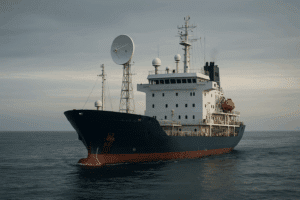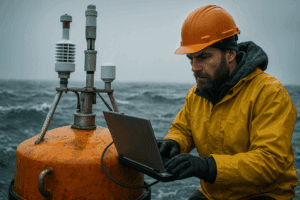How to Become a Smart Port
With a growing maritime and shipping industry, Smart Ports, ports encompassing technology innovations, care for the environment, and concern for surrounding stakeholders, are gaining popularity. Smart Ports have a competitive advantage in today’s world, for a Smart Port strategy allows maritime actors to do more with less. Becoming a Smart Port and going green is a priority, but many ports do not know where to start. That is why this article will go over the steps to becoming a Smart Port with Sinay.
90 percent of global trade is done by sea, 10 billion metric tons are traded by sea shipping, and more than 800 million cargo containers are handled on port interfaces each year. This puts immense pressure on ports and on the global supply chain. Clearly, ports must adapt to these increasing numbers, and we believe becoming a Smart Port is the best solution to improve logistics. Becoming a Smart Port is also the best solution to deal with the significant environmental impacts that are a result of this pressure put on ports. Therefore, a Smart Port transition helps ports to become more logistically and environmentally efficient.
Depending on port size, environment, infrastructure, logistics, security, operations, cargo amounts, time, automation, performance, and systems, different types of ports can choose different strategies.
Ports will have different pain points, stakeholders, and levels of maturity. To adopt a Smart Port plan, ports must take an inventory of all assets and data, identify their level of Smart Port maturity, identify their strategy according to management areas, choose their business and environmental objectives, and ensure these objectives are met.
Predict the ETA of any vessel for free!
Get an accurate prediction of the ETA of any vessel thanks to our ETA Calculator Module. It’s easy, in real-time and free. You just have to sign-up to our HUB.
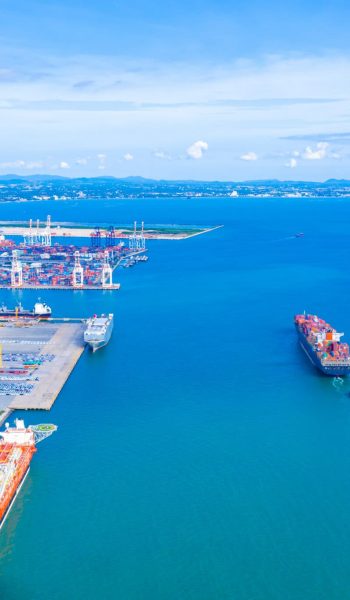
Step One: Inventory for Chosen Management Areas
Begin with an inventory of all port assets and activities. Ports can, for example, perform a gap analysis (what they have versus what a Smart Port should have). This includes collecting data, processing it, and identifying the gaps.
Ports could perform their inventory analysis based on the following 10 management areas (graph pictured below): (1) innovation management, (2) technological development, (3) safety and security, (4) environmental management, (5) logistics and hinterland development, (6) operations management, (7) cluster management, (8) administrative management, (9) trade management, and (10) people management.
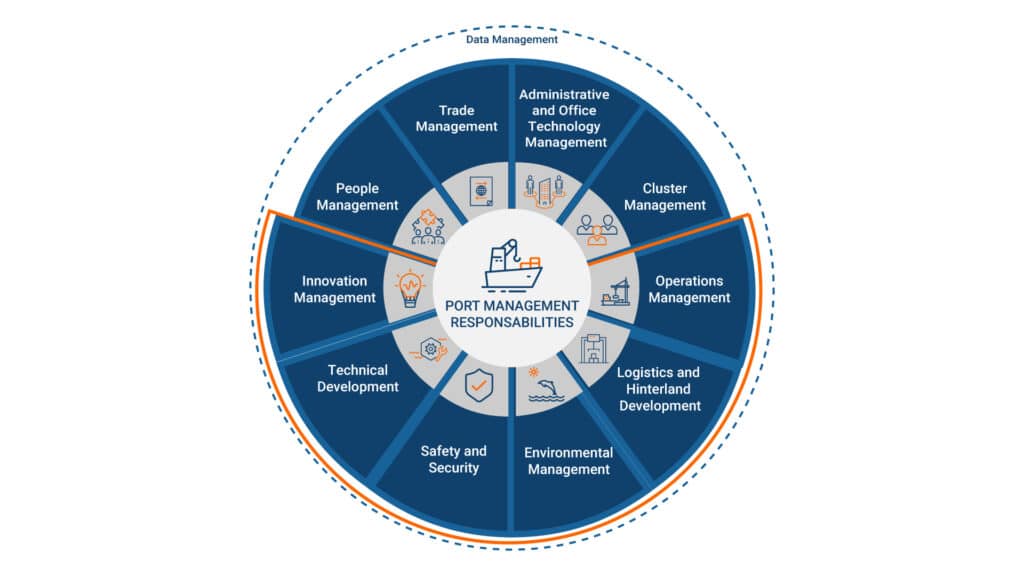
A Smart Port strategy normally does not encompass each management area at the same time. A port can start their Smart Port strategy by choosing one area to begin.
At Sinay, we help ports cover areas (1) – (6) in the above figure of their Smart Port strategy. As a Smart Port strategy covers many topics, at Sinay we focus on innovation, Big Data and Artificial Intelligence, safety and security, environmental and logistic management, and operations management.
As ports normally have large amounts of accumulated data, at Sinay we can help ports take inventory of current and past data with our Sinay Workshop. Our workshop is a state-of-play showing port inventory at that moment. Then we can perform steps 2 – 5 listed below.
We referenced the Inter-American Development Bank Smart Port Manual and the International Maritime Smart Index, when developing our how-to-become-a-smart-port strategy.
Step Two: Identify Smart Port Maturity Level
The retrieved inventory analysis allows ports to analyze their Smart Port status, and where they are in the process of maturity. When taking inventory, ports identify their level of maturity based on the four Smart Port maturity levels.
The Four Levels of the Smart Port Maturity
1. Organizational Level
This means that a port is in process of an internal digital transformation. At this level of maturity, a port is adopting technologies and digital transformations per organization to make their port practices and operations more efficient and less costly. However, this level of maturity equally indicates that many systems are still manual and need safety improvement. At this phase, many systems are still inefficient.
2. Port Connected Level
At a port connected level, ports advance from separate organizations being digitalized to the entire port facility being connected. Ports start to have automated processes between different parties. Port authorities and terminal operators, two main port stakeholders identified by Sinay, are more affected at this level as they begin to adopt an online system for systematically manual paperwork, processes, and safety. For example, when ships arrive, they fill out their data on a digital platform instead of paperwork. Therefore, this streamlines the security and safety processes.
3. Port Community Level
At this level, a port becomes an interconnected logistics hub. This level connects ports, surrounding communities, and the authorities together. Information becomes interconnected and organizations no longer work in information silos. Platforms and procedures are standardized so that sharing information becomes consistent, and procedural errors are not made by authorities. Information at this stage is shared between different actors so that duplications are avoided.
“To achieve transformation, the port industry should shift its strategy from simply controlling resources to managing resources, from optimizing internal processes to external interactivity, and from maximizing value for customers to maximizing value for the entire ecosystem.” – Yan Jun. CEO. Shanghai International Port (Group) Co., Ltd.
4. Hyperconnected Port Level
This is the highest level of Smart Port maturity. At this level, all actors are connected, and each organization’s business goals are efficiently being met. The entire environment is essentially digitalized and virtualized. At this stage technologies like Artificial Intelligence, Digital Twins (like that of Port of Rotterdam), Big Data, blockchain, IoT, and 5G networks are present. Not only that, but the port’s impact on the surrounding environment and community are taken into account. By this stage, individual port organizations have been digitalized and figured out a way to work together along with the community and outside actors to be an interconnected Smart Port. A port has many management areas, and it becomes smart when each management area is digitalized and automated. A Smart Port is not just data, but an ecosystem of partners.
Step Three: Develop Strategy Based on Maturity Levels and Management Areas
Once the level of maturity is identified, a strategy must be developed.
If at level 0, a port must acknowledge that they start internally by organization before developing an international Smart Port strategy.
If at level 1, individual organizations are focusing on how they can digitalize operations before working outside of themselves.
If at level 2, port systems have started to become automated, but at an individual level.
If at level 3, integrated systems have started being introduced to port processes, and they have started to connect with their hinterlands and surrounding communities.
Lastly, if identified at level 4, a port is smart and connected already using many kinds of integrated systems and solutions. At this level, a port has such a high level of maturity that they can lead innovations with an innovation incubator and assist other ports in Smart Port transition with port collaboration and partnerships. Once at the highest level of maturity, a Smart Port is still continuously evolving.
Many different strategies exist, and different ports will have different initiatives that they want to achieve. Ports must identify their pain points, where there are losing value, and what technologies and solutions they want to implement to improve operations and their environmental impact.
For example, if working with Sinay ports could choose to implement our Environmental Modules to help them monitor water quality, air quality, or noise quality to be a greener port. Ports could also choose to implement our logistics modules to help them predict precise estimated time of arrival (ETA) or accurately track vessel voyages to be more technologically connected with logistic activities.
Predict the ETA of any vessel for free!
Get an accurate prediction of the ETA of any vessel thanks to our ETA Calculator Module. It’s easy, in real-time and free. You just have to sign-up to our HUB.

Step Four: Implement Strategy
Once a strategy is developed and ports know what their Smart Port goal is, they can begin to implement it.
A Smart Port strategy can help to efficiently use all existing port infrastructure, connect ports with their surrounding community and hinterlands, improve logistics, create transparency, save energy, and help the environment.
To monitor strategy implementation, ports identify their objectives and create key performance indicators (KPIs) to measure them. Objectives are normally identified through four perspectives: operations, environment, energy, and safety and security. Indicators and goals are created for each of these perspectives.
For example, if a port has implemented the Sinay Water Module, they can set their objective to be that that they closely follow the real-time key performance indicators shown on the Sinay dashboard when performing their construction activities.
Step Five: Ensure Achieved Strategy Goals
Ensure that the strategy goals are being met by tracking objectives. Feedback is then always being given so that ports continuously measure and improve objectives.
This process is essentially a monitoring process to ensure the chosen Smart Port strategy is going to plan. With time ports will be able to identify how their chosen strategy is helping with their competitive advantage.
For example, if a port has chosen to implement the ETA Module, a module designed so ports know precise vessel estimated time of arrival, they can monitor how the new precise ETAs are improving their competitive advantage.
Takeaway
The below figure shows how we measure ports based on the six Smart Port management areas for which we can develop a Smart Port strategy. Ports can use this diagram to rate their level of maturity for each area. This rating should be done by many actors of the same port for an unbiased assessment.
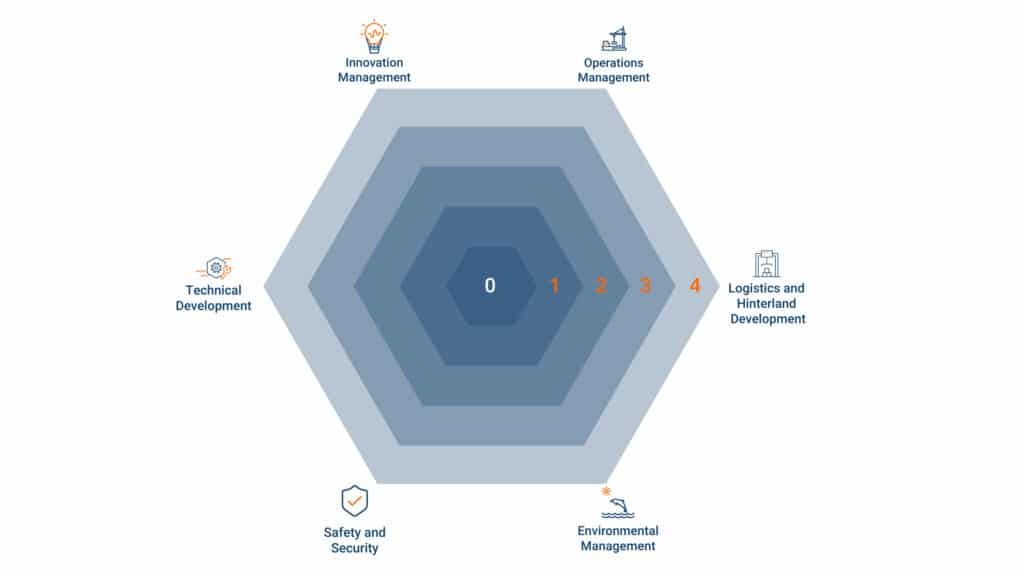
A port identified with no existing Smart Port strategy would be rated a level 0, while a hyper connected Smart Port would be rated as a level four on each management area section.
Therefore, Smart Port transformation involves many aspects, and these six aspects only incorporate what Sinay can cover.
At Sinay we offer a workshop approach as a partner for data management for the six management areas above, as understanding data is the key to becoming a Smart Port.
Sinay is a key partner in your Smart Port transition. We know how to improve your data management. Once data is properly managed, analyzed, and shared, it will be useful in all six management areas. Once ports understand data, they then know where they stand in relation to Smart Ports and at which level they can start to build their strategy.
Once strategies are identified, Sinay already has multiple software modules developed on the Sinay Hub, a 360-degree view of the maritime industry, that can be implemented into port operations to help a port become smart. Included are modules to improve environmental and logistical efficiency. Sinay can help ports track water and air quality, as well as precise vessel ETA.
We can also develop a premium personalized Smart Port approach and fully customized solution that meet specific port needs.
Sinay can help a port with their processes no matter how early or advanced they are in developing a Smart Port strategy and no matter the size of port.
Frequently Asked Questions About: HOW TO BECOME A SMART PORT
A Smart Port is a digital port. “Smart” means being more attractive and innovative in a competitive sense.
A Smart Port is a more effective, more performant, and more economically competitive port. Not only that, but Smart Ports consider residents a key stakeholder of their activities. They use real-time information, a collaborative management approach, and essentially provide more with less.
A Smart Port is green, digital, and more connected to logistics, industrial environments, and sustainable development resources. They are automated ports using new technologies while caring more for the marine environment.
Smart Port technologies include Big Data, Artificial Intelligence (AI), Internet of Things (IoT), blockchain technology, and 5G connection.

